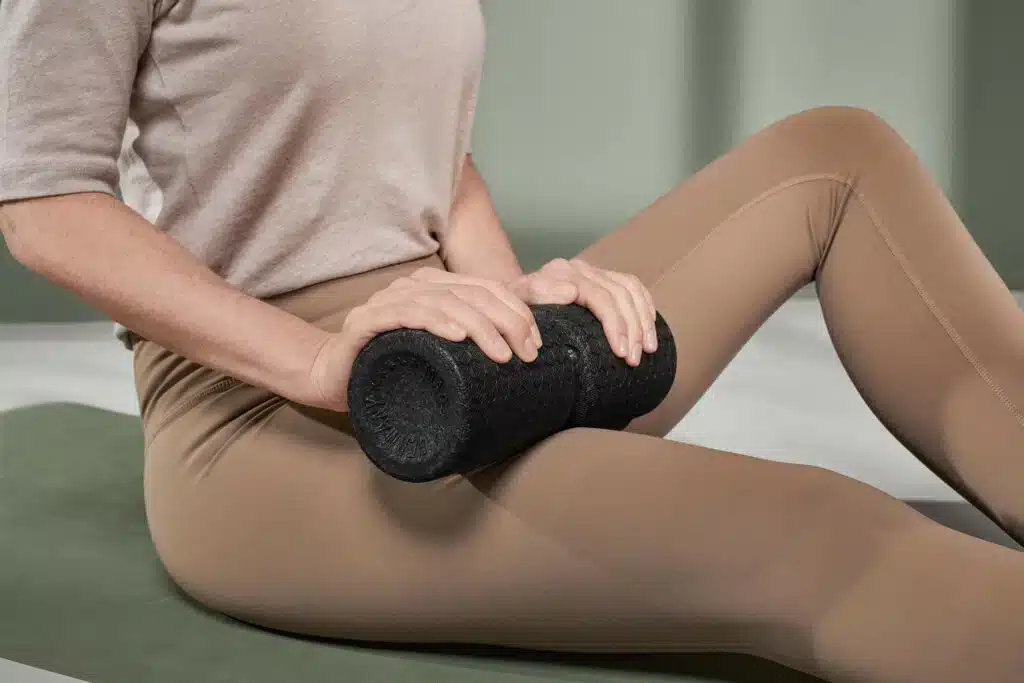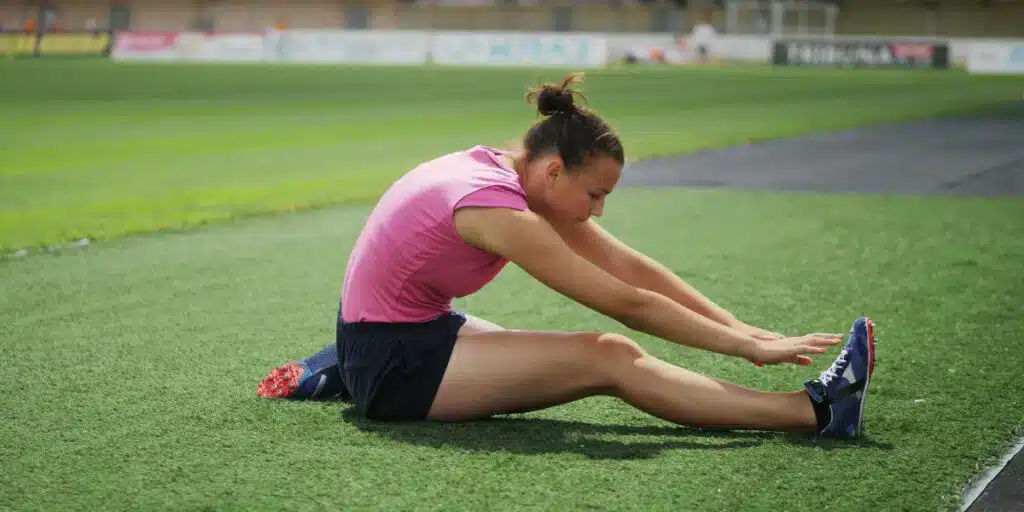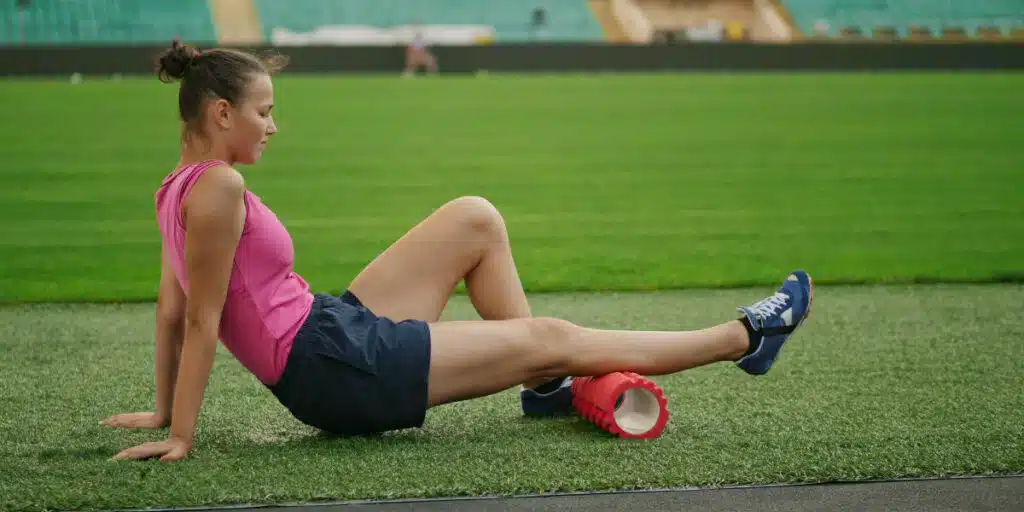Ever since selfies of LeBron James and Khloe Kardashian with their trusty foam rollers began popping up all over the internet, the cylindrical tools have become the new yoga mat. Social media is full of lifestyle gurus proclaiming that fascia rolling massages are excellent for post-workout recovery. Physical therapists have used the technique for years to decrease pain and increase mobility and range of motion. Gwyneth Paltrow even showed King of Late-night Jimmy Fallon how to foam roll massage on live TV.
Thanks to the hype, foam rolling has rolled out of the physical therapist’s office into the gym, yoga studio, and our homes.
But do fascia foam rolling massages really do anything, or is this a case of all-smoke-no-fire? How effective is the technique? How do foam rolling massages compare to stretching?
It turns out that LeBron, Khloe, and Gwyneth are on the right myofascial track. A recent study published in Sports Medicine proves that foam rolling massages improve mobility.
Improve Mobility & Help Yourself Against Pain With Liebscher & Bracht’s Foam Rolling Massages
Fascia foam rolling massage is a pillar of Liebscher & Bracht’s pain-relieving therapy. The technique was developed so people experiencing discomfort or limited mobility because of tense muscles and tight fascia could help themselves. We have a selection of foam rolling massage videos on our YouTube channel for each body part.
Visit Our YouTube Channel to Relieve Tension & Increase Mobility
Fundamental Flexibility & Fasica Rolling Massage Fact Finding
The more flexible we are, the easier our joints can move through their full range of motion. Flexibility is an absolute must for professional athletes, but it’s also essential for non-athletes; staying nimble helps us move freely through simple daily activities that we only notice when they cause pain.
Sports trainers and physical therapists spend significant time helping their patients and clients improve joint mobility.1)2)3)4) The countless exercises and tools for flexibility illustrate just how important joint mobility is.
The gold standard for increasing range of motion (ROM) is stretching exercises. 5)6)7)8) However, over the last twenty years, other approaches have been embraced by the medical community, one of which is the fascia rolling massage. Self-massages with fascial rollers (or other tools) developed as alternatives or supplements to stretching exercises. 9)
A team of Canadian and German researchers have reviewed worldwide studies to determine how fascia rolling massages positively affect joint mobility. The research team selected only studies that used trusted methodologies to obtain the most accurate results possible.
A Relevant Review With Reliable Results
The research team analysed randomised controlled trials (RCT), which measure the effectiveness of new treatments. The medical community considers RCT benchmark studies because they minimise bias and provide a reliable framework to examine the relationship between a treatment and its results closely.
The review included crossover trails and parallel studies.
A crossover trial is made up of two groups (A and B) and two treatments (treatments 1 and 2). Group A receives treatment 1, followed by treatment 2, while Group B gets the treatments in reverse.
A parallel study is made up of two or more groups of participants that receive one treatment. Each group gets a different treatment for the length of the trial.
Selecting the Studies
To be included in the review, the study had to have been conducted with healthy adults who self-massaged and measured the effect on their range of motion immediately after.
Of the 286 current research papers on fascia rolling massage, 26 studies met the team’s criteria. The total number of participants was 609. Participants were between 14 and 36 years old, with slightly more men than women.
The research team’s rigorous inclusion criteria have led to highly conclusive results.

© DedovStock | shutterstock.com
The Research Team’s Discoveries
The research team made a surprise discovery: fascia rolling massages have almost the same effect as stretching exercises. However, if the fascia rolling massages were done only for a short time, they were less effective than stretches.
Muscle groups responded differently to the fascia rolling massages. The hamstring and calf muscles were found to respond most significantly.
The front thigh muscles did not have a significant response.
The team also discovered that fascia rolling massages are slightly more effective for women than men. There is currently no explanation for why.
Compared to the placebo group (people who did nothing to improve their mobility), the group who performed the fascia rolling massages significantly increased their range of motion.

© DedovStock | shutterstock.com
Increasing Mobility. Decreasing Pain.
It still isn’t clear what happens to the body during fascia rolling massages that increase flexibility.10) It is assumed that it’s a combination of responses. Applying direct pressure to and manipulating the tissue stimulates blood circulation11), improves vascular function12) and increases the suppleness of the tissue. 13)14)
The effect of fascia rolling massage appears to extend beyond the area of the body being directly massaged, reaching the opposite side of the body. This indicates that the central nervous system also responds to fascia rolling massage. The parasympathetic nervous system is stimulated, triggering a release of serotonin, cortisol, endorphin, and oxytocin. These substances reduce the sensation of pain and increase mobility.15)
The New Gold Standard Treatment for Joint Mobility?
This review is the first detailed overview of international research that has been done on how effective fascia roll massages are for joint mobility. The review shows that fascia roll massage can successfully increase flexibility.
Foam roll massages can be used as a warm-up for sports activities as the effects are similar to stretching. High-performance athletes should consider fascia roll massages as an alternative to stretching since stretching can slightly reduce muscle strength. Less muscle strength can affect the results of performance during a competition. 16)17)18)19)
People whose mobility is compromised because of joint pain or inflexibility should strongly consider fascia foam rolling as a treatment.
The results of this review indicate that fascia foam rolling could become a new gold-standard therapy to help improve joint mobility.
Sources & Studies
- ↑1 Simenz, C. J., Dugan, C. A., & Ebben, W. P. (2005). Strength and conditioning practices of National Basketball Association strength and conditioning coaches. Journal of strength and conditioning research, 19(3), 495–504.
- ↑2 van Baar, M. E., Dekker, J., & Bosveld, W. (1998). A survey of physical therapy goals and interventions for patients with back and knee pain. Physical therapy, 78(1), 33–42.
- ↑3 van der Wees, P. J., Hendriks, E. J., Jansen, M. J., van Beers, H., de Bie, R. A., & Dekker, J. (2007). Adherence to physiotherapy clinical guideline acute ankle injury and determinants of adherence: a cohort study. BMC musculoskeletal disorders, 8, 45.
- ↑4 Wilke, J., Niederer, D., Vogt, L., & Banzer, W. (2018). Head coaches' attitudes towards injury prevention and use of related methods in professional basketball: A survey. Physical therapy in sport : official journal of the Association of Chartered Physiotherapists in Sports Medicine, 32, 133–139.
- ↑5 Harvey, L., Herbert, R., & Crosbie, J. (2002). Does stretching induce lasting increases in joint ROM? A systematic review. Physiotherapy research international : the journal for researchers and clinicians in physical therapy, 7(1), 1–13.
- ↑6 Decoster, L. C., Cleland, J., Altieri, C., & Russell, P. (2005). The effects of hamstring stretching on range of motion: a systematic literature review. The Journal of orthopaedic and sports physical therapy, 35(6), 377–387.
- ↑7 Radford, J. A., Burns, J., Buchbinder, R., Landorf, K. B., & Cook, C. (2006). Does stretching increase ankle dorsiflexion range of motion? A systematic review. British journal of sports medicine, 40(10), 870–875.
- ↑8 Medeiros, D. M., Cini, A., Sbruzzi, G., & Lima, C. S. (2016). Influence of static stretching on hamstring flexibility in healthy young adults: Systematic review and meta-analysis. Physiotherapy theory and practice, 32(6), 438–445.
- ↑9 Cheatham S. W. (2019). Roller Massage: A Descriptive Survey of Allied Health Professionals. Journal of sport rehabilitation, 28(6), 640–649.
- ↑10 Behm, D. G., & Wilke, J. (2019). Do Self-Myofascial Release Devices Release Myofascia? Rolling Mechanisms: A Narrative Review. Sports medicine (Auckland, N.Z.), 49(8), 1173–1181.
- ↑11 Hotfiel, T., Swoboda, B., Krinner, S., Grim, C., Engelhardt, M., Uder, M., & Heiss, R. U. (2017). Acute Effects of Lateral Thigh Foam Rolling on Arterial Tissue Perfusion Determined by Spectral Doppler and Power Doppler Ultrasound. Journal of strength and conditioning research, 31(4), 893–900.
- ↑12 Okamoto, T., Masuhara, M., & Ikuta, K. (2014). Acute effects of self-myofascial release using a foam roller on arterial function. Journal of strength and conditioning research, 28(1), 69–73.
- ↑13 Wilke, J., Niemeyer, P., Niederer, D., Schleip, R., & Banzer, W. (2019). Influence of Foam Rolling Velocity on Knee Range of Motion and Tissue Stiffness: A Randomized, Controlled Crossover Trial. Journal of sport rehabilitation, 28(7), 711–715.
- ↑14 Morales-Artacho, A. J., Lacourpaille, L., & Guilhem, G. (2017). Effects of warm-up on hamstring muscles stiffness: Cycling vs foam rolling. Scandinavian journal of medicine & science in sports, 27(12), 1959–1969.
- ↑15 Weerapong, P., Hume, P. A., & Kolt, G. S. (2005). The mechanisms of massage and effects on performance, muscle recovery and injury prevention. Sports medicine (Auckland, N.Z.), 35(3), 235–256.
- ↑16 Behm, D. G., Blazevich, A. J., Kay, A. D., & McHugh, M. (2016). Acute effects of muscle stretching on physical performance, range of motion, and injury incidence in healthy active individuals: a systematic review. Applied physiology, nutrition, and metabolism = Physiologie appliquee, nutrition et metabolisme, 41(1), 1–11.
- ↑17 Simic, L., Sarabon, N., & Markovic, G. (2013). Does pre-exercise static stretching inhibit maximal muscular performance? A meta-analytical review. Scandinavian journal of medicine & science in sports, 23(2), 131–148.
- ↑18 Kalichman, L., & Ben David, C. (2017). Effect of self-myofascial release on myofascial pain, muscle flexibility, and strength: A narrative review. Journal of bodywork and movement therapies, 21(2), 446–451.
- ↑19 Cheatham SW, Kolber MJ, Cain M, Lee M. The effects of self-myofascial release using a foam roll or roller massager on joint range of motion, muscle recovery, and performance: a systematic review. International Journal of Sports Physical Therapy. 2015 Nov;10(6):827-838.
